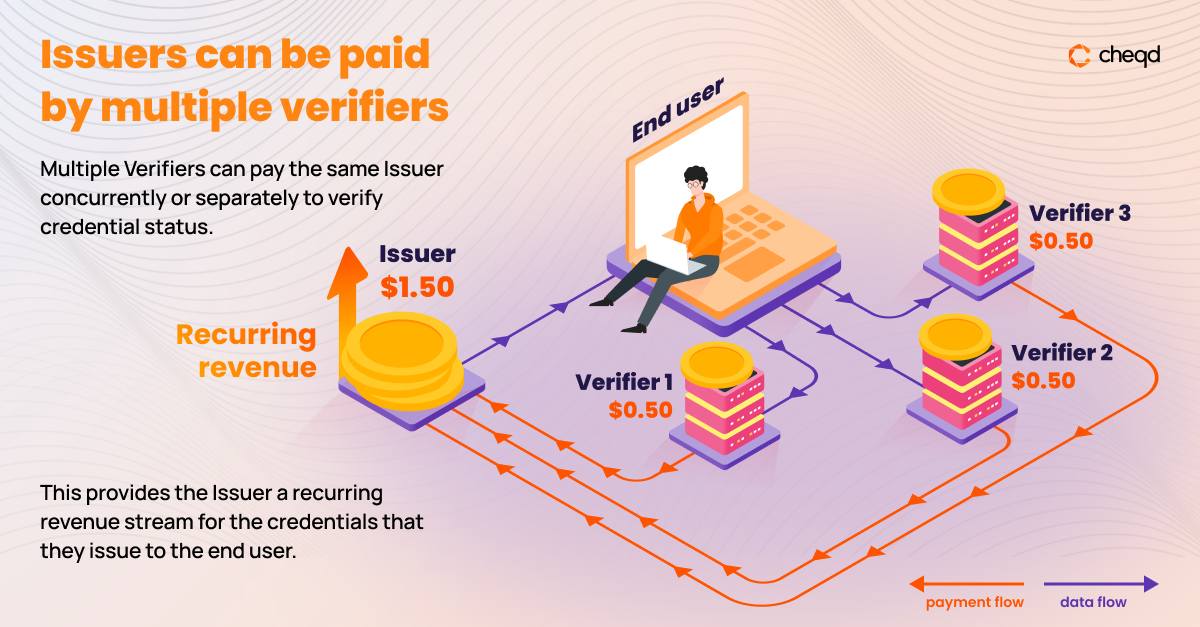The Next Big Opportunity
Every technological era births new economic models. The Agentic Economy, where AI agents drive value creation in society, is set to be the next anticipated shift, much like the early days of Software-as-a-Service (SaaS). Similar to how SaaS changed the way businesses accessed software, the Agentic Economy will redefine workflows and responsibilities across industries.
Interestingly, trust is the foundation that determines the success of any new economic models. The Agentic Economy will only thrive if businesses and individuals can rely on AI agents. This is where Verifiable AI becomes indispensable. It ensures the reliability and trustworthiness of AI driven interactions.
This blog explores the market potential of Verifiable AI and how it could catalyse a 10x economic impact compared to SaaS. More importantly, we’ll delve into $CHEQ’s role in this shift.
Join $CHEQ in building the trusted backbone of this new agentic era. Let’s embrace the full potential of Verifiable AI.
Contact us to build verifiable trust into your AI model.
Economic Implications of AI Agents
The rise of AI agents represents a new wave of economic shift, changing the way businesses and industries operate. As these smart agents become more embedded in various aspects of our personal and professional lives, their impact is evident in several key areas:
1. Reduced Repetitive Tasks, Leading to Leaner Teams
- AI agents can take over up to 40% of the work people do today, and in some places, even 60%, according to a report from the IMF.
- Most of these refer to simple, everyday routine tasks like scheduling meetings, entering data, and answering customer questions.
- Example: Chatbots and virtual assistants can resolve more than 80% of basic customer queries, so human workers can focus on complex issues.
2. The Rise of New Job Roles
- Just like SaaS-created roles like cloud architects and DevOps engineers, AI will spark new careers, too.
- AI Agent Managers – People who make sure AI systems work well and improve them.
- Verification Specialists – Experts who check that AI is accurate, reliable, and follows rules.
- AI Ethicists – People who make sure AI is fair and used in the right way.
- Market insight: By 2030, 30% of the biggest companies (Fortune 500) will use AI agents to provide services, according to Gartner.
3. Economic Implications for Businesses
- Efficiency Gains: AI agents can reduce operational costs by up to 30% while increasing productivity.
- Example: AI-infused virtual agents can cut labor costs by reducing the reliance on human intervention, leading to as much as 30% decline in customer support service fees.
- Revenue Growth: Companies leveraging AI agents report faster product cycles and enhanced customer experiences, driving revenue increases.
- Example: McKinsey’s research indicated that businesses adopting AI sales agents achieve a rise in sales ROI by 10-20%.
4. Examples of Companies Already Leveraging AI Agents
- Salesforce: Integrates AI agents for customer relationship management, enabling smarter, faster decision-making.
- Microsoft: Employs AI-powered Copilot to assist with coding, content creation, and data analysis, boosting productivity.
AI agents can be described as catalysts for the new economic era. Companies that leverage these smart agents early will gain a substantial advantage, making it harder for others to catch up. Conversely, companies that wait too long might struggle to keep up because their competitors will already be ahead.
The Market Opportunity: 10x Bigger Than SaaS
The Agentic Economy, driven by AI agents and Verifiable AI, is creating a market opportunity that could be more than 10 times bigger than SaaS. The number illustrates the significance, and in reality the impact is even greater. To get a sense of its potential, think about how fast new technology catches on, how much more efficient businesses can become, and the ripple effects across numerous industries. It is a shift that’s going to be huge.
SaaS fundamentally changed how software was consumed. The global market, valued at $143.77 billion in 2021, is expected to grow to $720.44 billion by 2028. But the Agentic Economy, a completely new model, is on track for even more explosive growth. Experts at PwC predict it could reach $15.7 trillion per year by 2030. The number tells. From static workflows to smarter, AI-powered systems, the trend is unstoppable.
The PwC research also shows that 45% of total economic gains by 2030 will come from product enhancements, making them more appealing to consumers. This is because AI will create more product choices, make them more personalised, and lower costs over time. The greatest economic gains from AI will be in China (26% boost to GDP) and North America (14.5% increase), equivalent to a total of $10.7 trillion and accounting for almost 70% of the global economic impact.

The accelerated adoption of AI agents offers a clear comparison to SaaS’s growth trajectory. A prime example is DeepSeek, which gained over 1 million users in just 14 days and hit 10 million users in only 20 days. That’s way faster than early SaaS products like Dropbox. This kind of rapid growth signals the AI agent market is expanding quickly and could create immense value.

While AI agents automate more processes and decisions, concerns around accuracy and security also mushroom in parallel. The need for trust and reliability in AI agents is escalating. Verifiable AI boosts the economic impact of the Agentic Economy by resolving these challenges.
Why Verifiable AI Is Crucial for Founders and Users
Verifiable AI is a solution offered by cheqd. It helps to build trust along the AI information supply chain, ensuring all interactions are verifiable. This refers to those between a company and a user, an agent and a user, or between multiple agents. Let’s examine each scenario.
- Company/User Relationship: a company can issue verifiable credentials to users to confirm attributes or approve qualities. These include identity, qualifications, or membership . These credentials establish a foundation of trust to the rest of the world, enabling users to interact securely with services and platforms without exposing unnecessary personal information.
- Agents/User Relationship: Verifiable credentials act as a proof to verify an agent’s authority to act on behalf of an individual or an organisation. Vice versa, a user can present a verifiable credential to an agent, proving their eligibility to access certain services.
- Agent/Agent Interaction: As noted above, this extends to multi-agent interactions, where AI agents communicate with each other to validate information and execute tasks while ensuring each entity in the chain is verified.
In the process, every AI output can be traced back to its source. This provides a way to verify the authenticity of information fed and claims made. For businesses, the main advantage is that Verifiable AI can assist with more efficient decision-making, fewer operational risks, and improved customer trust. On the other hand, consumers can be assured that the AI systems they interact with follow stringent standards, enhancing their confidence in digital products and services. The trust established along the pipeline is especially critical in sectors like finance, healthcare, and law, where errors can lead to large-scale economic and health impacts.
cheqd is committed to developing payment and trust infrastructure for credentials and Verifiable AI. Its infrastructure enables seamless exchanges of verifiable credentials powered by $CHEQ, making sure that AI agents operate with integrity. Businesses can integrate Verifiable AI into their operations at every stage of the AI information supply chain for the sake of building trust and safeguarding their interests while unveiling new opportunities in the Agentic Economy.
How $CHEQ Powers the Agentic Economy
The Agentic Economy, fueled by AI agents and Verifiable AI, is revolutionising business operations and creating new ecosystems. It’s not merely about saving money. It’s also creating new ways for companies to earn and share value. A big part of this is tokenised systems, where trusted data becomes a key part of economic growth.
The cheqd infrastructure plays an important role in this shift. By facilitating credential payments and enabling trusted data exchange. It enables AI agents to securely pay for and exchange trusted data powered by $CHEQ, making sure they can interact safely across different settings. This is crucial because, for the Agentic Economy to grow, people and businesses need to trust that the AI agent they interact with is reliable.
cheqd’s model creates a multiplier effect on tokenomics. While more AI agents adopt Verifiable AI, the demand for credential verification and data exchange grows, increasing the utility of $CHEQ. This feedback loop drives the adoption of AI agents as well as strengthens $CHEQ’s role as a foundational player in the trusted economy.
Just as SaaS gave rise to platforms like AWS and Salesforce, the Agentic Economy is building a new digital world based on trust. $CHEQ is leading this change by enabling seamless, secure transactions that construct the Agentic Economy. For example:
- In healthcare, $CHEQ enables the secure exchange of verifiable credentials for patient records.
- In finance, $CHEQ helps prevent fraud by verifying AI-driven risk checks and ensuring compliance with regulations.
- In travel, AI agents can make itinerary adjustments and bookings using $CHEQ.
Embrace Verifiable AI and the Agentic Economy
The implications of the Agentic Economy are expansive. Its market potential could be more than 10 times bigger than SaaS, changing the way businesses work and creating entirely new industries. By combining AI agents with the trust framework supported by Verifiable AI, the real question isn’t if the Agentic Economy will take over, but how fast companies will adjust to make the most of it.
cheqd ($CHEQ) is leading this change by building the trusted data infrastructure that makes Verifiable AI possible. With $CHEQ, AI agents can securely exchange trusted data, make payments for verified credentials, and help scale digital economies (tokenised ecosystems). $CHEQ is the core enabler of a world where AI agents can operate efficiently and reliably.
Join $CHEQ in building the trusted backbone of this new agentic era. Let’s embrace the full potential of Verifiable AI and become part of the movement that will define the future of society.






